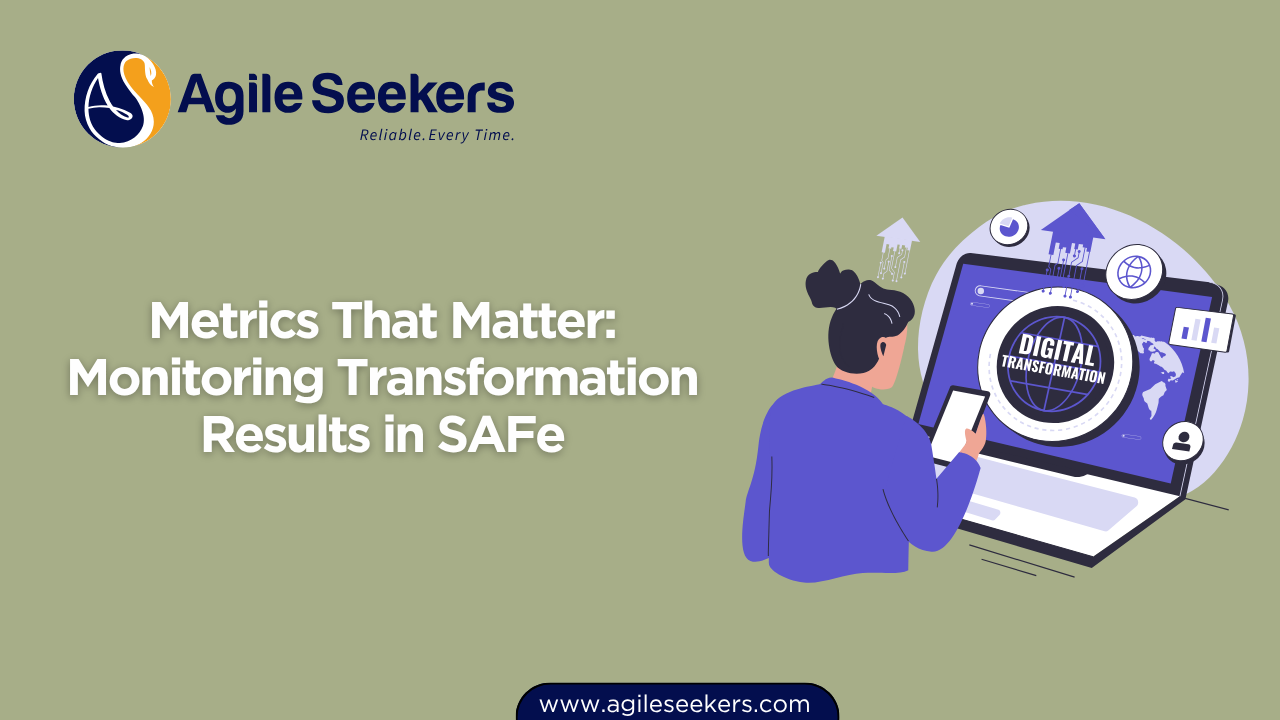Metrics That Matter: Monitoring Transformation Results in SAFe

When organizations adopt the Scaled Agile Framework (SAFe), one of the most critical—but often misunderstood—areas is measurement. Transformation isn’t just about launching Agile Release Trains (ARTs) or running PI Planning. It’s about realizing real business outcomes. And that only happens when leaders track what truly matters.
In this post, we’ll explore the metrics that matter most in a SAFe transformation, how they tie to business objectives, and what roles like Product Owners, RTEs, and Scrum Masters can do to monitor and adapt based on these signals.
Why Metrics Matter in SAFe Transformations
Any change initiative that lacks measurement becomes a guessing game. In SAFe, metrics are not just operational; they’re strategic. They tell leadership whether Agile adoption is leading to faster time-to-market, better quality, and higher customer satisfaction.
SAFe encourages three levels of measurement:
- Portfolio Level – Business outcomes and strategic progress.
- Program Level – Flow, predictability, and team performance.
- Team Level – Tactical delivery metrics.
1. Business Outcome Metrics
Business outcome metrics track the actual impact of your transformation. Are you solving the right problems? Are your solutions delivering value?
Examples include:
- Customer Satisfaction (NPS or CSAT)
- Revenue or Cost Savings Attributed to Agile Initiatives
- Time to Market for Strategic Themes
- Strategic Initiative Completion Rate
These help validate whether initiatives funded through the Lean Portfolio Management function are delivering expected returns. Certified professionals with SAFe POPM Certification are trained to define features and capabilities that tie directly to business value.
2. Flow Metrics: Measuring Delivery Efficiency
SAFe emphasizes flow-based thinking. The goal is to optimize the entire value stream, not just individual teams. The six flow metrics introduced by SAFe are:
| Flow Metric | Definition |
|---|---|
| Flow Velocity | Number of completed items over a time period |
| Flow Time | Time it takes for work to go from start to finish |
| Flow Load | Number of items currently in progress |
| Flow Efficiency | Ratio of active work time to total time |
| Flow Distribution | Percent split across features, defects, tech debt, enablers |
| Flow Predictability | How often teams deliver what they committed to |
These are especially important for Release Train Engineers (RTEs), who use flow data to identify bottlenecks and support ART improvement.
3. Team and ART Predictability
The Program Predictability Measure (PPM) tells us how well teams meet their PI Objectives:
(Sum of Actual Business Value / Sum of Planned Business Value) × 100
Scrum Masters support predictability by coaching on planning, estimation, and flow. Certified professionals with SAFe Scrum Master Certification or SAFe Advanced Scrum Master Certification help teams mature in this space.
4. Technical Health Metrics
Technical debt and poor quality can derail any Agile transformation. Metrics to track include:
- Escaped Defects
- Automated Test Coverage
- Build Failure Rates
- Cycle Time for Bug Fixes
Practices taught in Leading SAFe Agilist Certification Training support technical excellence through DevOps and built-in quality.
5. Lean Budgeting and Investment Efficiency
SAFe’s Lean Budgeting approach makes funding dynamic. Monitor:
- Budget vs. Actual Investment
- Cost of Delay (CoD)
- Funding-to-Value Ratios
This supports informed financial decisions, ensuring that investments go toward initiatives delivering real outcomes.
6. Cultural and Engagement Metrics
Agile success also depends on people. Monitor:
- Team Engagement Scores
- Agile Maturity Assessments
- Cross-Functional Collaboration Indicators
External tools like Comparative Agility can help assess Agile mindset and culture evolution.
Balanced Metrics Dashboard Example
| Category | Metric Example | Target Range |
|---|---|---|
| Business Outcomes | Net Promoter Score (NPS) | 50+ |
| Flow | Flow Time for Features | < 15 days |
| Predictability | Program Predictability Measure | 80–100% |
| Technical Health | Escaped Defects per PI | < 5 |
| Investment Alignment | Value Delivered / Cost Incurred | > 1.5 |
| Engagement & Culture | Team Engagement Index | 4+ (out of 5) |
Best Practices for Monitoring Metrics
- Focus on outcomes, not just delivery activity.
- Review regularly in ART syncs, I&A, and retrospectives.
- Avoid vanity metrics. Tie every measure to decision-making.
- Enable visibility across levels using dashboards.
- Empower teams to act on insights, not just report them.
Conclusion
Tracking the right metrics gives you visibility into whether your SAFe transformation is truly delivering results. Whether you're a Scrum Master, Product Owner, RTE, or Portfolio leader, understanding and acting on these signals can make or break your Agile journey.
Also read - Tracking Progress in SAFe: How to Measure What Matters
Also see - Running Effective SAFe Workshops to Align Business and Technology Leaders




















